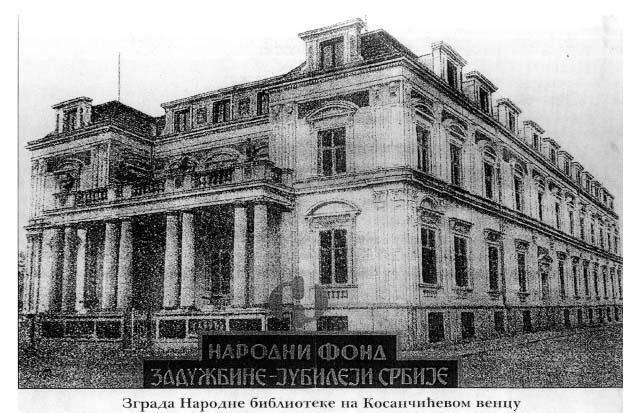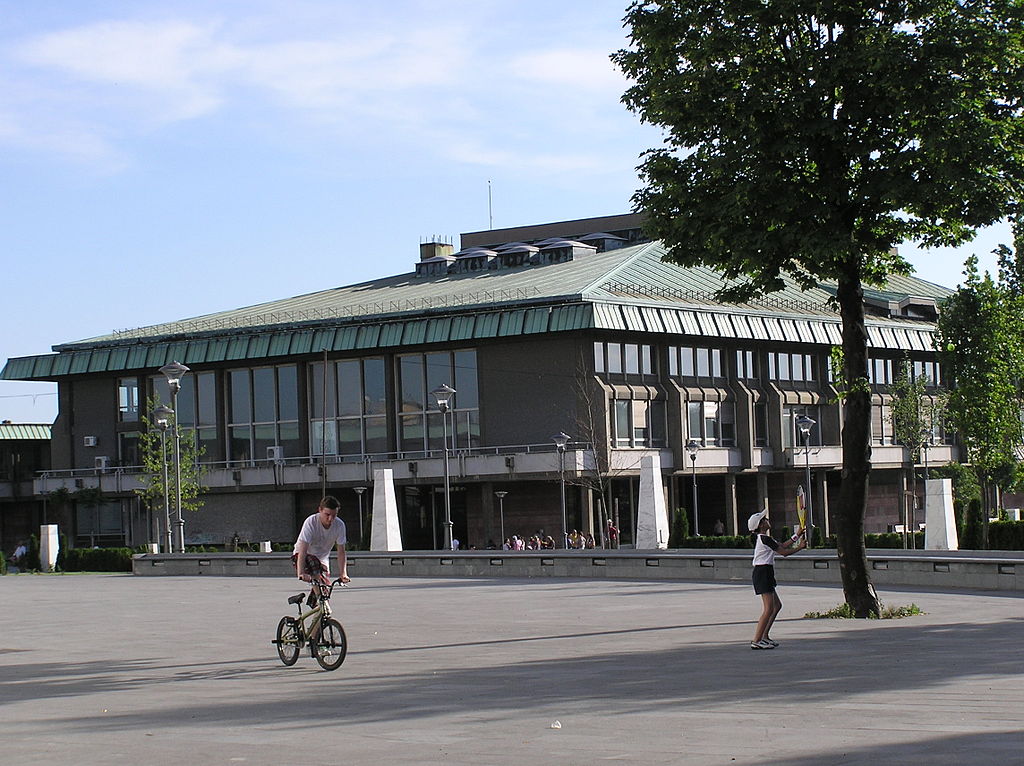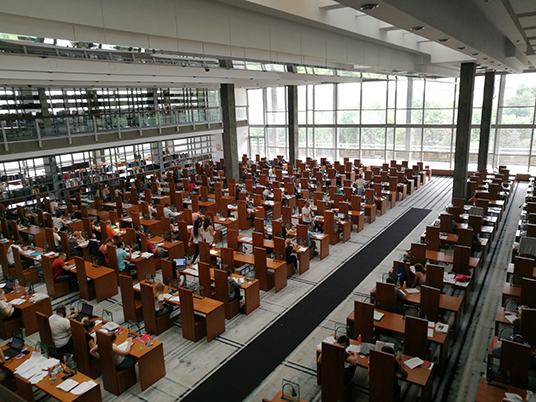By Sonja Ćirić
Eighty years after the building on Kosančićev Venac, housing the National Library of Serbia was completely destroyed in the bombing of Belgrade in the Second World War, the Library is now given a new impetus.
Just before marking the 80th anniversary of its annihilation by the Nazi bombs in the Second World War, it was announced that the construction of an additional depot at the National Library of Serbia will start. These two pieces of information, one about the disappearance and the other about progress, symbolically represent the life of the National Library of Serbia, concomitant to the name people in Serbia gave it – Our Phoenix.

The National Library of Serbia is our oldest cultural institution. It was founded in 1838 by the then Ministry of Education, and since then, it has been one of the most important pillars of national culture. Furthermore, the National Library of Serbia has the most important and most abundant collection of movable cultural heritage in this part of Europe. It contains close to five million units, covering almost 1,000 years. It is the home of the Virtual Library of Serbia, which has been creating a joint catalogue with close to 180 other libraries and over 2.5 million library records. The building on the Vračar plateau, where it is located, was built in 1973. Before that, the National Library had been on a constant move.
From address to address
“Insufficiently cared for by our own state and left to exceptional experts and devotees to look after it, through its turbulent history, the National Library shared the destiny of the Serbian people and the state,” said Dejan Ristić, historian and one of the Library’s directors, in his book “The House of Incombustible Words”.
In the first few years after its establishment, the Library moved around Belgrade about ten times, and only once did it get its own space. The construction of a building that would house the National Library was first attempted in 1860. The Ministry of Education addressed the Main Directorate of Buildings with the initiative to construct a building for the needs of the National Library and the Museum of the Serbian Land (today’s National Museum). They received an affirmative answer the day after – a project was drafted, the required permits were obtained and then the General Directorate of Construction informed the Ministry of Education that, due to the reduced budget, it would not be able to implement the agreement by the year end. However, the Library continued to move around Belgrade the following year too. When the First World War erupted, the Library was housed in Captain Miša’s building on today’s Studentski Trg, in multiple rooms.
“The National Library of Serbia has the most important and most abundant collection of movable cultural heritage in this part of Europe”
The second attempt to construct a building that would house only the National Library was in 1905 at the initiative of librarian Jovan N. Tomić. Four years later, a building plot was allocated in today’s Francuska Street, sketches of the space and its precise layout were made, and then in 1912, King Petar I verified the decree, passed by the National Assembly, to transfer part of the funds intended for the construction of the Library to other purposes. Subsequently, it turned out that the allotted land was needed for the construction of the Main Post Office, with the promise that the Library would soon get its own space. Then came the Balkan Wars, followed by the First World War.

Two crates
At that time, the National Library was located in Captain Miša’s building (since 1864). Dejan Ristić says in his book the Library had almost 60,000 library units and only nine employees. “This information is especially valuable given the events that followed,” he said, noting that “the day after Baron von Giesl, the Austro-Hungarian ambassador to Belgrade, handed over his government ultimatum to Deputy Prime Minister and Finance Minister, Lazar Paču, librarian Jovan N. Tomić was ordered to separate the most valuable manuscripts and old printed books, pack them in two boxes, take them to the railway station and put them in the train car belonging to the Ministry of Foreign Affairs, to be sent to Kruševac.”
“There aren’t many nations and countries to whom the written word meant so much for survival, as is the case with Serbia”
At that time, the National Library of Serbia had 219 incunabula – old manuscripts and old printed books. Nobody knows the contents of those two crates because the list of contents was either destroyed or did not even exist, which is very possible due to the short time which Jovan Tomić was given to pack them up. The destiny of the material that was in the two boxes is still not known. It is believed that during the First World War, more than fifty precious medieval manuscripts and charters from the national fund disappeared. The whereabouts of a few are known, while the search is still on for 27 manuscript books.
At the end of the First World War, and after five decades of staying at Captain Miša’s building, the National Library moved to the building of the former Savings Bank of the Vračar Cooperative, in today’s Miloš Veliki Street. Working in such conditions was unsustainable. Again, thanks to librarian Jovan N. Tomić, the authorities addressed the problem of the National Library and in 1921, bought a building on Kosančićev Venac, known as the “building on Šanac”, where the Library was supposed to take up permanent residence.

Bombing
In that beautiful, harmoniously built neoclassical building, the library, unfortunately, experienced complete destruction, on April 6, 1941, during the Nazi bombing of Belgrade, exactly 80 years ago. On that day, the national fund, not counting library materials received in the first three months of that year, had 354,000 volumes of monographic publications, 1,365 manuscripts, 226 early printed books, about 6,260 magazines and newspapers, close to 3,770 letters and 1,447 units of cartographic material, graphics and photographs.
The building was bombed during the third air raid, between 3:30 pm and 6:00 pm. The bombers flew in from the direction of the Great War Island and hit the entire Kosančić Venac. Based on the testimony, Dejan Ristić wrote that “the library building was first hit by one incendiary bomb, at most two, which passed through the roof in the back of the building, and that the fire was smoldering under the roof for a long time. It was possible to neutralize the projectiles by burying them in the sand, which was delivered to the National Library promptly. The latter fires could have been extinguished with hand tools that had been stored in the attic since the beginning of 1941, but, unfortunately, in those dramatic moments, there was no one in the National Library to do that. ”
The reasons for the bombing of the National Library of Serbia can be primarily seen in the very core of the ideology of Nazi Germany. As a result of its racial theory, every material, historical and cultural trace of those nations who had not been considered as belonging to the superior Aryan race became the target of the German government and its armed formations. Consequently, the cultural heritage was looted and in most cases, deliberately and systematically destroyed.
Thirty-two years later, the current building of the National Library of Serbia was opened. Willy Brandt was the first foreigner to visit it, who came a few days after the opening and brought a package of books as a sign that Germany acknowledged what happened in the Second World War. The legendary French Minister of Culture, Andre Malraux, gave to the Library his book about Pablo Picasso, thus reminding us of the book burning incident that took place on April 6, 1941.
On February 28, the date when Dimitrije Davidović sent a letter to Prince Miloš about the opening a library in 1832, the National Library marked its 189th anniversary. On that occasion, the Minister of Culture, Maja Gojković, said that the Library has become an irreplaceable institution on the cultural scene of Serbia, as well as that it is not only a guardian of the collective memory but also an authentic contemporary peer. “There aren’t many nations and countries to whom the written word meant so much for survival, as is the case with Serbia. Here, in the Library, precious manuscripts of our national and cultural heritage are kept, which help us to lay a better foundation for what we will be by showing us what we were and what we are now,” the Minister stated. She also announced that the National Library would digitize its material and work on popularizing reading among younger audiences in the coming period.
The construction of the depot will solve the problem of the lack of space for adequate storage of valuable and extensive library materials. This will be new momentum for Our Phoenix.